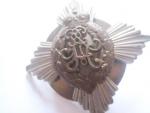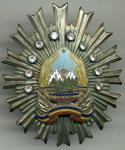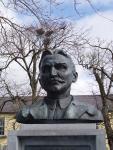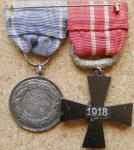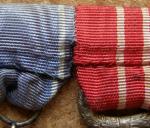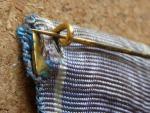-
Posts
9,099 -
Joined
-
Last visited
-
Days Won
4
Content Type
Profiles
Forums
Blogs
Gallery
Events
Store
Everything posted by Kev in Deva
-

Romania The Romanian Securitate
Kev in Deva replied to Greg Collins's topic in Central & Eastern European States
There is a series of "Friends of . . ." Badges, including "Friends of the Fire-brigade", "Friends of the Library" etc . . etc. . . probably aimed at the youth members of the Communist Party, Young Pioneers etc..etc..There is a lot of items being attributed to the "Securitate" just for sales purposes, and I am living in Romania since 2003 and have never seen a "Securitate" Uniform, in the flesh or on any pictures, possibly because they wore ordinary military uniforms and opperated on a strict "need to know" basis as it suited their work to have a low profile. Kevin in Deva. :beer: -

Imperial Russia need help identifying piece
Kev in Deva replied to logicalming's topic in Russia: Imperial
-

Romania The Romanian Securitate
Kev in Deva replied to Greg Collins's topic in Central & Eastern European States
Can you post a close up of the Young Trooper badge. Thank you. Kevin in Deva. -

Australia's last WWI vet dead at 110
Kev in Deva replied to Les's topic in The Great War 1914 to 1918
May he + Rest In Peace + Another chapter of Australian Military history closes. -
For starters please take a look at:- http://www.worldwar2.ro/forum/index.php?showtopic=1147 The Forum is located at:- http://www.worldwar2.ro/forum/index.php?act=idx Kevin in Deva. :beer:
-
Hallo Gents I have recently obtained three 1916 dated postcards from a chap in the K. u. k Gebirgskanonenbatterie 2/18 these are unusual in that they are folding types, double the normal postcard size showing a place called HOCHENEGG. There is a lot of penciled info on them, but its in Hungarian if I re-size the pictures detail is lost, can I send them to anybody by email who would be kind enough to post them, and get a translation? Many thanks, Kevin in Deva.
-

Me? Host?
Kev in Deva replied to Tom Y's topic in Germany: Third Reich: Uniforms, Headwear, Insignia & Equipment
Hallo Tom congratulations with your "appointment". "With age comes wisdom" so Ricky wont feel so lonely now Super collection of items Kevin in Deva. :beer: -

Romania Romanian defence of social order
Kev in Deva replied to bifter's topic in Central & Eastern European States
Well I wish he would post pictures, that would save all the guess work Kevin in Deva. -

Romania Romanian defence of social order
Kev in Deva replied to bifter's topic in Central & Eastern European States
Probably means that all the yellow enamel was removed in the example that bifter received? Kevin in Deva. :beer: -

Romania Romanian defence of social order
Kev in Deva replied to bifter's topic in Central & Eastern European States
-

EK 1939 Suspicious Shinkel?
Kev in Deva replied to shaneos3's topic in Germany: All Eras: The Iron Cross
Are not WW2 EK I with maker mark "20" known fakes? Kevin in Deva. -

Romania Romanian defence of social order
Kev in Deva replied to bifter's topic in Central & Eastern European States
Without pictures its hard to comment, but it sounds like you did not get the item you paid for, contact the seller, send it back, and demand a refund and feel free to name the seller. Dont hold your breath on that happening you have been fobbed off with a damaged piece, there were no rare variations issued Kevin in Deva. :beer: -
Hallo Gents,with reference Major John MacBride (note correct spelling of name) John MacBride was born at The Quay, Westport, County Mayo, Ireland to Patrick MacBride, a shopkeeper and trader, and the former Honoria Gill, who survived her son.[1] He was educated at the Christian Brothers' School, Westport and at St. Malachy's College, Belfast. He worked for a period in a drapery shop in Castlerea, County Roscommon. He had studied medicine, but gave it up and began working with a chemist firm in Dublin. He joined the Irish Republican Brotherhood and was associated with Michael Cusack in the early days of the Gaelic Athletic Association. He also joined the Celtic Literary Society through which he came to know Arthur Griffith who was to remain a friend and influence throughout his life. Beginning in 1893, MacBride was termed a "dangerous nationalist" by the British government. In 1896 he went to the United States on behalf of the IRB. On his return he emigrated to South Africa.He took part in the Second Boer War, where he raised the Irish Transvaal Brigade. Despite being known as MacBride's Brigade its first commander was in fact an Irish-American, Colonel John Blake, an ex-US Cavalry Officer. The Brigade was given official recognition by the Boer Government, the commissions of the Brigade's officers were signed by State Secretary FW Reitz. He was commissioned with the rank of major in the Boer army and given Boer citizenship. The 500 Irish and Irish-Americans fought the British. Often these Irish commandos were fighting opposite such Irish regiments as the Dublin Fusiliers and the Inniskillings. From the hills around the besieged town of Ladysmith to the plains of the Orange Free State, MacBride's Brigade first looked after the Boers' great Long Tom gun, then fought in the Battle of Colenso and later held the rearguard, harassing Lord Roberts' cavalry as the Boer army retreated. However, a larger number of Irish fought for the British against the Boers. By May 1900 the Irish commandos had split, not unexpectedly, into two Irish Transvaal Brigades. Distractions were also caused by the arrival in the Irish camp of an Irish-American Ambulance corps as well as by the news that Irish nationalist leader Michael Davitt had arrived in the Boer capital. Meanwhile, back home Irish pro-Boer fever, whipped up by Arthur Griffith and Maud Gonne in what was the most popular and most violent of the European pro-Boer movements, proved to be a 'dry run' for 1916. After the war he travelled to Paris. In 1903, he married the Irish nationalist Maud Gonne, who he had met in 1900 and through whom he had met W. B. Yeats. The following year their son Sean MacBride was born. After the marriage failed amid accusations of domestic violence he returned to Dublin. Gonne separated from MacBride, but never remarried. MacBride, unlike the other leaders of the Easter rising in Dublin in 1916, was not a member of the Irish Volunteers, and happened to find himself in the midst of the Rising without notice, but he offered his services to Thomas MacDonagh and was appointed second-in-command at the Jacob's factory. MacBride, after a court martial under the Defence of The Realms Acts, was shot by British troops in Kilmainham Gaol, Dublin. He was executed on 5 May 1916, two days before his fifty-first birthday. Facing the British firing squad, he refused to be blindfolded, saying "I have looked down the muzzles of too many guns in the South African war to fear death and now please carry out your sentence." He is buried in Arbour Hill Cemetery (Dublin). W.B. Yeats, who had hated MacBride during his life largely because of Yeats' unrequited love for Maud Gonne and who had heard negative reports of MacBride's treatment of Gonne in their marriage, gave him the following ambivalent eulogy in his poem "Easter, 1916": "This other man I had dreamed A drunken, vain-glorious lout. He had done most bitter wrong To some who are near my heart, Yet I number him in the song; He, too, has resigned his part In the casual comedy; He, too, has been changed in his turn, Transformed utterly: A terrible beauty is born." Kevin in Deva.
-
Could you please post a picture of the ribbon bar? Kevin in Deva
-

Cost of medals
Kev in Deva replied to muckaroon1960's topic in Great Britain: Orders, Gallantry, Campaign Medals
Nothing whatsoever to do with the credit crunch, IMHO there are two main values in regards military Decorations, the historic value and a monetary value. it has more to do with the demand, many collectors specialize in specific areas, the gallantry regardless of country are always in demand. particularly so with WW1 medals as the 100th Anniversary draws near. Another thing to be taken into consideration is that the rarer scarce orders and decorations, again regardless of origin, are being bought as an investment with an eye on the future. I can for example add 3% - 4% to the value of my collection yearly and see it reflected in the prices being asked for and paid online or in auctions. Kevin in Deva. -

Bundesrepublik The new "Iron Cross"
Kev in Deva replied to webr55's topic in Germany: Post 1945: Bundesrepublik & DDR
IMHO as it was never issued in that shape / style, post 45 then it doesn't mean much trying to proclaim, its connected to the "IRON CROSS" from days gone by. Kevin in Deva. -

Bundesrepublik The new "Iron Cross"
Kev in Deva replied to webr55's topic in Germany: Post 1945: Bundesrepublik & DDR
The shape of the cross on todays German aircraft, bears little resemblance to the shape of the original Iron Cross, apart from its black and a cross -

Silesian Eagle H vv O
Kev in Deva replied to Kev in Deva's topic in Germany: Weimar Republic & Deutsche Freikorps
Many thanks for the link, I missed this example when looking through the posts on these birds Kevin in Deva. -

Bundesrepublik The new "Iron Cross"
Kev in Deva replied to webr55's topic in Germany: Post 1945: Bundesrepublik & DDR
It will never happen, as the reputation of the Iron Cross is shot after WW2. Anyway nobody ask soldiers what they think of the quality of the awards, the parade, they salute, they accept, Kevin in Deva. -

Bundesrepublik The new "Iron Cross"
Kev in Deva replied to webr55's topic in Germany: Post 1945: Bundesrepublik & DDR
Hallo TacHel. I.M.H.O. there is no comparison between the French Legion of Honour & British V.C. and the Prussian / German Iron Cross period. The early awards of the Prussian Iron Cross were only awarded for wars against France. Many of the Royal Houses from the associated German states carried their own high awards for bravery, many more aesthetic and beautiful designed than the Iron Cross, and some of these designs would be nice to see resurrected. The 1939 Iron Cross version was morphed into an abomination by hitler and his cronies, and tarnished forever. And it will never be reinstated, politics will see to that, along with the fact that this new award is now officially to replace it. Whereas the British Victoria Cross was awarded for Bravery, irrespective of Rank and in many Campaigns. The French Legion of Honour is in quite a similar position. And the French & British "somewhat questionable periods" (depending on your politics and views) will never rate as high as those German 1936 - 1945 period in the minds of the people in todays modern world, at least not while there are Allied veterans and civil survivors of the W.W.2. period. Kevin in Deva. Post Edit:- As I omitted to quote the post, to which I was responding too. -

Finland Cross of Liberty 4th class with red cross.
Kev in Deva replied to Kev in Deva's topic in Northern European & Baltic States
-

Finland Cross of Liberty 4th class with red cross.
Kev in Deva replied to Kev in Deva's topic in Northern European & Baltic States
-

Finland Cross of Liberty 4th class with red cross.
Kev in Deva replied to Kev in Deva's topic in Northern European & Baltic States
-

Finland Cross of Liberty 4th class with red cross.
Kev in Deva replied to Kev in Deva's topic in Northern European & Baltic States


